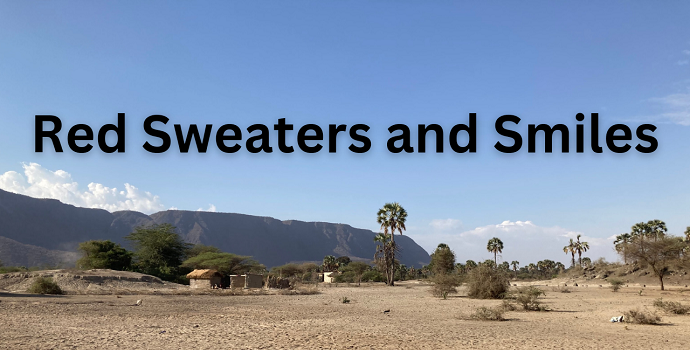
I’ve never been the type of girl who likes to go four-wheeling. Haven’t ever thought of it as something to enjoy on the weekend. But, for the past sixty days or so, Monday to Friday, that is exactly what I’ve done. The 20 minute ride from the village of MtoWaMbu to the Mungere school in the northern part of Tanzania is a four-wheeling experience like no other. Across the scrubby plain we go, with the escarpment that is the Great African Rift looming above us like an ancient sleeping giant. The way is lined with termite mounds and flat-topped acacia trees, and bomas surrounded by fences made from the branches of that tree that is symbolic of Africa. Until recently, the Land Rover we are in would battle piles of dust. Carrying a scarf became a necessity as dust seeped into every crevice of the vehicle. But now, with the rains coming, the dust has given way to puddles of mud. Either way it’s a bumpy ride. Our trip leads us toward the escarpment and the brown scrub gives way to a (slightly) more lush environment.
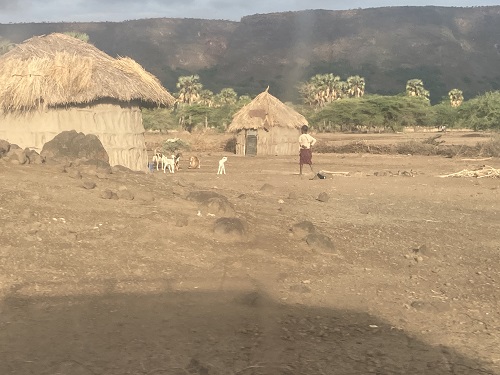
The students of Mungere school travel from various places in the area: Mungere, Kambi Ya Mkaa, Majengo (A and B), and even as far as Kigongoni. The Mungere kids are of the Masai tribe, and it is their family’s bomas that are scattered about the plain surrounding the school. They travel by foot or by bike, bumping along through the dust or mud, just like us teachers. Some have to travel for an hour or more and I imagine them waking before dawn to make the trek that will ultimately shape their future.
The secondary school in Mungere, home of the Red Rhinos, was established to educate students whose education would otherwise have ended with primary school. In Tanzania, secondary school is a luxury, paid for only by families who have the means. Especially among the Masai girls (one of 120 local tribes), schooling is often overlooked for other duties. Mungere provides a low-cost, high-quality education for about 140 students whose families wouldn’t otherwise be able to afford further education.
We teachers arrive at the gate to be greeted by waiting students. There are eleven staff members and we are all loaded into the Land Rover, jostling each other as we hurdle the last few ditches before entering the school compound. The students are smiling, happy to see us. The happiness on their faces is a stark contrast to the landscape; knowing the living situation of most of these students, it’s hard at first to understand what causes the joy that they exude. It’s school. A routine, an opportunity to better their future. A place that gives them two meals a day, clean water, and dedicated teachers. They come, every day, in their bright red sweaters, blue skirts or trousers, light blue shirt and tie. They are proud to be here.
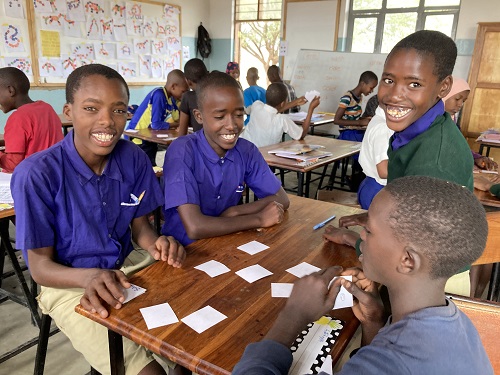
Students begin the day by doing chores, which includes watering baby trees, clearing the tree beds, and cleaning the classrooms. When the bell rings, they line up for “parade”– each “form” making a line in the yard. Announcements are given by the staff, reminders about bringing textbooks back, the importance of keeping the uniform clean, and upcoming events. Then, a group of students holds a short lecture or acts out a skit, usually academic, sometimes funny. Finally, classes are underway. The four forms retreat to their classes where they will stay as teachers rotate through teaching their various subjects. There is no electricity here, so windows and doors are open for light and a cool breeze.
Students learn all those familiar subjects that are universal to most schools: Biology, Maths, Chemistry, Physics, Geography and English. They also learn their native tongue, Kiswahili, and Agriculture, a subject that will allow them to possibly make a genuine contribution to their communities.
Tea time and lunch are taken after period 1 and period 3, respectively. “Tea”, or breakfast, is usually porridge or a sweet potato and tea. Lunch is routine as follows: Ugali and beans on Monday, Makande (beans and maize mixed) on Tuesday and Thursday, beans and rice on Wednesday, and on Friday the students eat meat with greens and rice. After learning for four 80-minute class periods, the students have a period to do what they like. They can study (before their exams), have religion class, or play sports or games. More recently, they have been practicing songs and dances for the big graduation party on December 3.
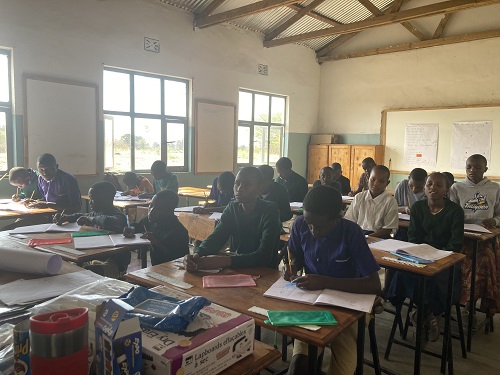
For 8 weeks, the class known as the “pre-forms” attend the Mungere school to be immersed in English learning before they officially start their secondary education here, where all subjects are taught in English. It is to this class that I am assigned. Each day I look upon 38 eager faces. I surprised myself by learning all of their names by week two, after much stumbling over names like Ng’Aboli and Nginye. I am ashamed to admit that for a while, the two Elizabeths, Judith, and Samson were often the ones called on, as I wracked my brain to remember the others. Now, as we are approaching our last week together, Razaki, Luqmani, Halima and Elipendo roll right off my tongue. Each and every one is as unique as their name, and I have enjoyed immensely my time with these bright and endearing students. Ranging in age from 12-18 (some began late!), they have all added an extra dimension to my life. As that (now cliché) statement goes: I learned more from them than they did me. Cliché or not, it is the truth. Many have never ridden in cars or watched a television set. Most of them have only two outfits, some only one, that they wear everyday. They love stickers. Even the teenage boys peel off the hearts and rainbows that I was afraid might seem babyish. One Friday, we had a party. Because MtoWaMbu has limited stock, there were enough cookies for each student to have two and also about five potato chips. They all waited patiently for everyone to get some. When we said, “go ahead, eat your snack!”, they hesitated. I’m still not sure why, but I’m guessing this was a VERY rare treat. But they caught on. Soon they were chatting and eating, all the while with those incredible smiles they wear every day.
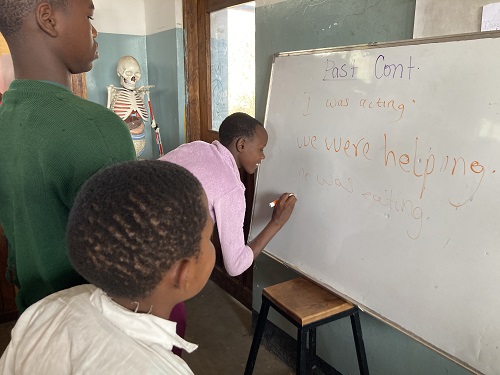
We cruised through the English curriculum. They amazed me – their capacity for learning and their ability to adapt (to me and my teaching style!). They had a single exercise book, a pen and a pencil each. There was no rhyme or reason to where they wrote assignments, which didn’t feel right to my used-to-keeping-everything-in-order mind. But after a while, I stopped trying to organize them, because they knew exactly where to find everything they had written. When supplies are scarce, kids adjust. And my feeling is they had been doing it this way from the start. Sharing is never a problem- they just do it. I frequently look up to see a student on the other side of the room getting their pen or pencil back from whoever borrowed it last, or getting their stuff out of the backpack of one of the four kids that own them. They are a community, in the true sense of the word. They look out for each other, they hold hands, they share and empathize. They don’t complain. So, we will cruise through our last week here which will culminate in a graduation party that the whole community will attend. Form four will move on to bigger and better things, and my pre-forms will begin their secondary careers. It will be bittersweet. Living in Africa is hard, and I’m ready to be back in my soft bed eating my favorite foods (although Makande may be on that list now). But I will miss these faces, smiling, eager, and hopeful.
My time here, volunteering to teach these soon-to-be Red Rhinos, will quite possibly be the only time I visit this school, or even this ancient continent. But this was a once in a lifetime adventure, and I will always thank myself for making this choice. Eight weeks has gone by fast, but I’m guessing my 38 preforms will remain imprinted in my heart forever.
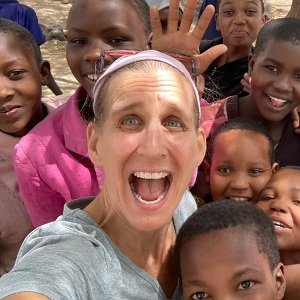 Kimberly Comerford is an Oxford Seminars graduate with over 20 years of teaching experience. She received her bachelor’s in History from Radford University in Virginia, and later earned her teaching certification with an emphasis on Special Education. Kim has taught in Vietnam, Tanzania, and the USA, and enjoys working with all types of learners. She also enjoys yoga and meditation when she’s not in the classroom.
Kimberly Comerford is an Oxford Seminars graduate with over 20 years of teaching experience. She received her bachelor’s in History from Radford University in Virginia, and later earned her teaching certification with an emphasis on Special Education. Kim has taught in Vietnam, Tanzania, and the USA, and enjoys working with all types of learners. She also enjoys yoga and meditation when she’s not in the classroom.

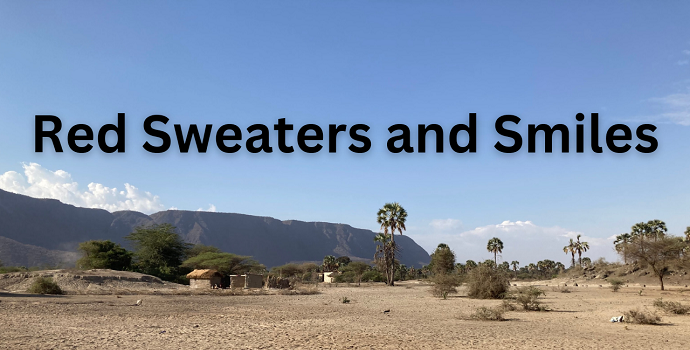







Leave a comment